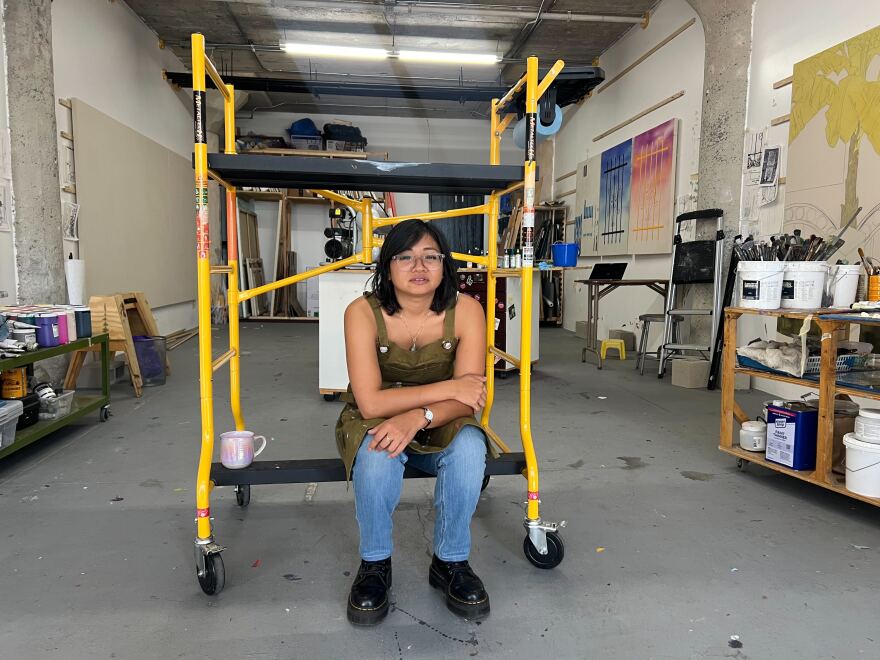Truth matters. Community matters. Your support makes both possible. LAist is one of the few places where news remains independent and free from political and corporate influence. Stand up for truth and for LAist. Make your year-end tax-deductible gift now.
Documenting LA By Painting Intimate Spaces: Meet Artist Tidawhitney Lek

For the last five years, artist Tidawhitney Lek’s work has focused on the domestic space in Los Angeles. She paints contemporary figurative, representational works, incorporating the residential architecture of L.A. Sunsets, palm trees and those curly iron security bars so common on houses throughout L.A. show up on her canvases.
She recently spoke with How To LA about how she got started, and her process. It’s all part of an occasional series in which we hear from artists about how they see the city.

Finding her voice
Lek grew up in Cambodia Town in Long Beach and moved to downtown L.A. two years ago. After graduating from Cal State Long Beach in 2017, she spent some time trying to find her voice, and what she wanted her artwork to represent.

“I ended up kind of slowly picking apart that I’m female, I'm a Cambodian American. I started picking apart into vulnerable places,” Lek says.
Her parents moved from Cambodia to the United States in 1979 after the Khmer’s Rouge’s genocidal regime fell. Her family had witnessed a great deal of violence, taking on trauma that was passed on to younger generations. As a first-generation American, Lek wanted to better understand her family’s journey and her upbringing. But it was challenging.
“I couldn’t get the conversation going or they just wouldn’t open up,” Lek says. “So when I gave up, I just was like,’you know what? Let me throw this into the painting.’ It really forced out this natural narrative that I’ve been getting to articulate.”
Her big break
If you go to The Hammer Museum to check out the Made in LA exhibit, you'll see one of her paintings called Refuge. It’s three panels — the left one is of a pink and orange sunset with palm trees, the right one is what looks like the inside of an L.A. apartment, and the middle panel shows girls watching fire and violence envelop a Cambodian landscape.

Lek had to work her way up to get to this moment where she gets to share her family’s story, and 2020 was the year she says everything came together for her.
“It was the pandemic,” Lek says. “It kind of just did this reset button in the circuit.”
Her stories started to resonate with people. “I was just like OK, this is where I’m supposed to be,” Lek says.
She soon after had her in-person debut where she did group shows. Then last year, she had her solo debut. She’s now led solo shows in L.A., London and New York.
“I do hear many times that, like, I need my story to be told,” Lek says.
The process of making a painting
Lek says all of her paintings start off with a raw canvas. She gives herself three choices: pastel, oil or acrylic paint. She uses different techniques, like watercolor.

“I start with that to help build the soft ground,” Lek says. “And then start really kind of dissecting and juxtaposing acrylic and oil. Because oil paints kind of erode other materials, they have to be last.”
Relatives is another piece at The Hammer Museum. It’s a picture of central figures — two women — standing on opposite sides of a fence in front of a house. It’s a feeling of watching two women saying goodbye after spending some time together.

“It’s actually based off of my baby cousins, and I captured two with a specific pose or posture, and I thought it resonated so well, the kind of air or attitude that's in the household of a lot of women that I was with,” Lek says.
Her identity in her work
In her work, you can see notes of femininity and a lot of L.A. landscapes and events. She mixes her heritage, culture, and her experiences with L.A. and Long Beach.
"I think I'm just really taking the step to own where I come from, and where I come from was not really like the best,” Lek says.
She adds: “I grew up on Section Eight. It wasn't always an easy neighborhood. But I'm trying to piece it up in beautiful ways because I don't remember it being horrible, I just have memories of it. I have a lot of gratitude for what has been in my life.”
Hear more about Lek’s work in the latest How To LA podcast episode. Three of her paintings are now on display at The Hammer Museum Made in LA exhibit through Dec. 31.







